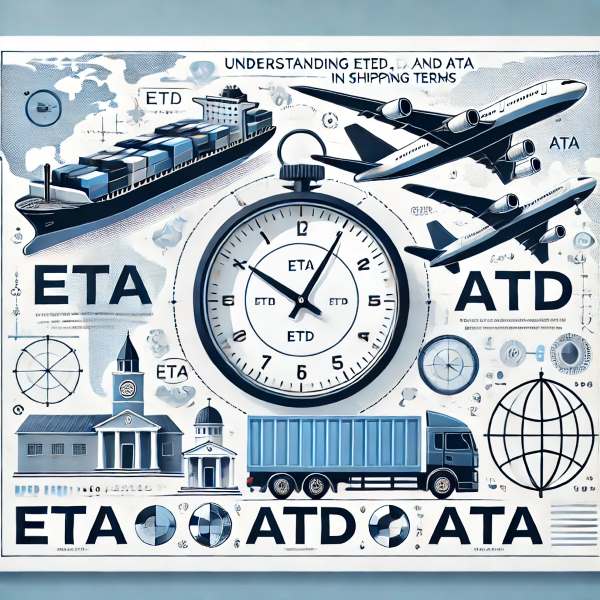In international logistics, time management is an important factor in ensuring efficient and timely transportation of goods. ETA, ETD, ATD and ATA are common transportation terms that involve key time points in the process of cargo transportation, which will be introduced in detail in this article.
Maybe it helps you: The 11 Common International Trade Terms

What does ETA Mean in Shipping?
ETA refers to the estimated time a transportation vehicle (such as a ship, plane, or truck) reaches its destination. The time point is calculated based on the departure point, transportation time, route and possible delay factors.
For the consignee, ETA is a very important time point that directly affects the planning of receiving goods, customs clearance and subsequent logistics arrangements.
What does ETD Mean in Shipping?
ETD refers to the time when the transportation vehicle is expected to leave the departure point. This is usually the starting point in the freight plan.
It provides buyers and sellers with a time reference before the goods are shipped, which helps to reasonably arrange production plans, inventory management and delivery processes.
What does ATD Mean in Shipping?
ATD is the time the vehicle actually leaves the place of origin. It may be inconsistent with ETD due to weather, delays in loading and unloading goods or other reasons.
It reflects the time when the goods actually start to be transported, and is an important basis for evaluating transportation efficiency and adjusting transportation plans.
What does ATA Mean in Shipping?
ATA is the time when the means of transport actually arrives at the destination. It records the time point when the transportation is completed, and is usually compared with ETA to evaluate the punctuality of transportation.
It provides the exact time when the goods actually arrive, which helps the consignee to arrange the receipt, customs clearance and subsequent sales or processing plans in a timely manner.
Factors Affecting ETA, ETD, ATD and ATA
Weather conditions
Storms and dense fog may cause delays in sea and air transport, affecting ETA and ATA.
Port and airport efficiency
Congestion or failure of loading and unloading equipment may cause ETD delays.
Vehicle speed
A discrepancy between the actual speed of the vehicle and the planned speed will affect the ETA.
Regulations and inspections
Customs inspections and enforcement of port regulations may cause ATD delays.
Transit and layovers
Stops or transit times may exceed expectations, affecting the total transportation time.
Application of ETA, ETD, ATD and ATA in logistics
- ETA: In international trade contracts, ETA is often used as part of the delivery time clause to ensure that both parties have clear expectations for the arrival time of the goods.
- ETD: It is widely used in international trade contracts, bills of lading and transport documents, and is an important basis for both parties, carriers and related parties to confirm the cargo transportation plan.
- ATD and ATA: In the field of logistics and transportation, ATD and ATA can reflect the deviation of the actual transmission time of goods from the shipping point to the receiving point relative to the expected transmission time, which helps to evaluate transportation efficiency, adjust transportation plans and optimize cost control.
How Familiarity with ETA, ETD, ATD and ATA Can Help You
After clarifying what logistics events mean, it is worth clarifying how they help facilitate the shipping process in practice. Depending on the role you play in logistics activities, freight tracking data can help you:

Provider
Knowing about logistics events such as ETA, ETD, ATD and ATA, you can plan your shipments more effectively. If you know when your ship is ready for shipment or waiting at the destination port, you can avoid additional storage and transportation costs, thus optimizing your operations and costs.
China Freight Forwarder
These four events are important for you to determine the best shipping routes and minimize delays when transporting goods. Knowing exactly when the goods will arrive, you can plan subsequent transactions. This way, the path from supplier to buyer will become more cost-effective and streamlined.
Consignee
It becomes easier to track and receive goods when you know the exact date and time when the ship will arrive with its cargo. This way, you can optimize delivery plans because you know how much time you need to calculate to prepare your equipment to receive the goods. Delays can be predicted and unnecessary expenses can be avoided.
Port Operators
For the convenience of all participants in logistics activities, port operators use ETA, ETD, ATD and ATA events to optimize and control shipping operations. These indicators form the basis for a fast cargo turnaround in ports, thereby minimizing delays when ships depart and arrive.
Customs Brokers
ETA, ETD, ATD and ATA are used to streamline all logistics operations. Including the timing of customs formalities. Timely and accurate customs clearance is achievable as long as logistics events are taken into account. Knowing these indicators, you can determine whether a ship is ready for customs clearance or when it is waiting for customs clearance; therefore, customs brokers can prepare the necessary documents and organize customs clearance in a timely manner.
Learn more: The Difference Between DDP and DAP in International Trade
The Meaning of CPT in International Trade
The Meaning of FAK in International Trade
ETA, ETD, ATD and ATA are core time points in logistics and supply chain management, which can help companies optimize transportation plans and improve overall operational efficiency. They can also help to make international transportation more efficient.
